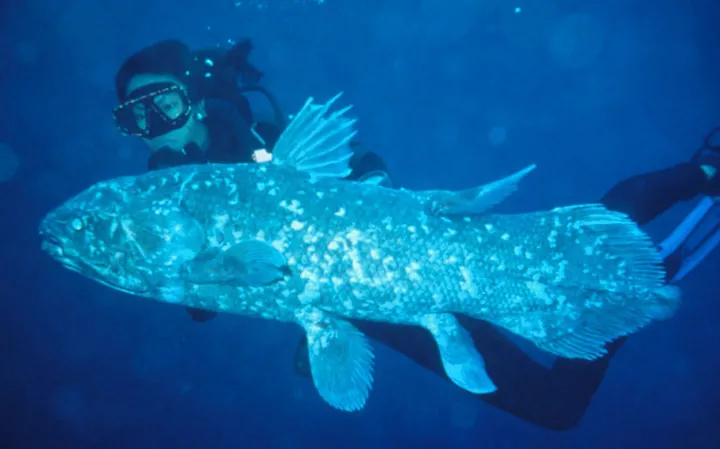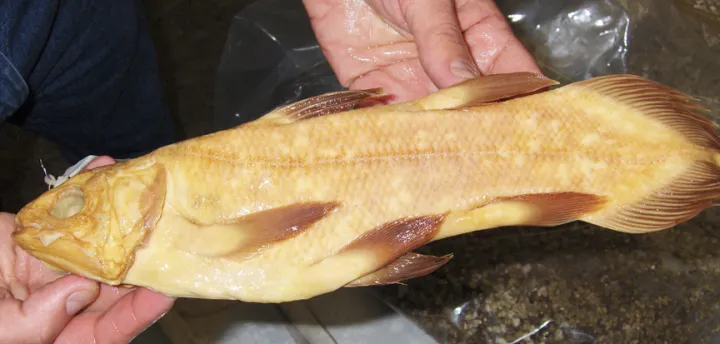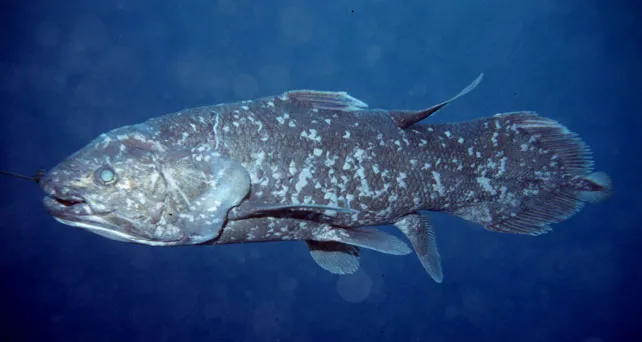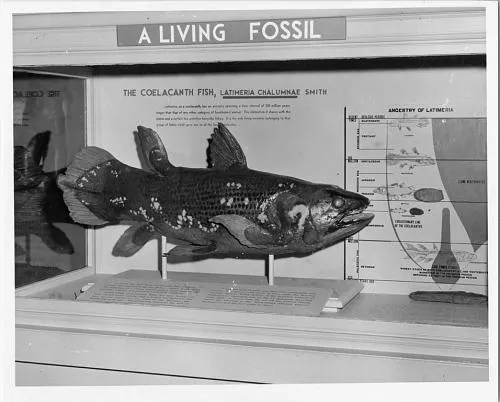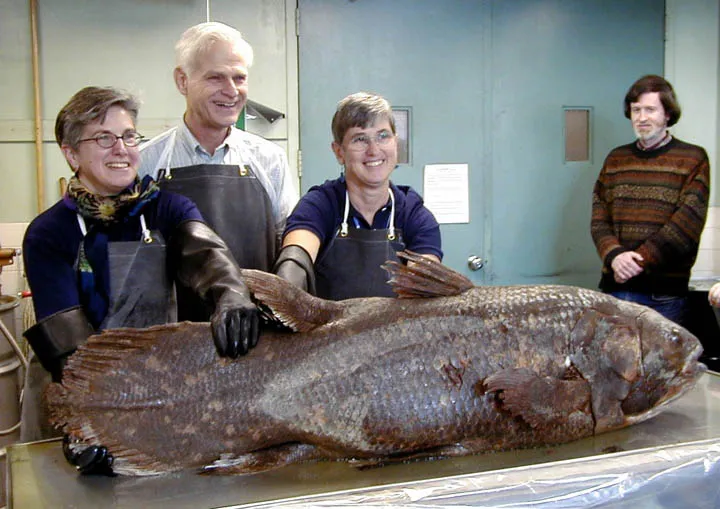
Coelacanth
Introduction
One of the world's most famous "living fossils," coelacanths (seel-a-canths) were once thought to have gone extinct approximately 65 million years ago (mya), during the great extinction in which the dinosaurs disappeared. It wasn't until 1938 when a live coelacanth was caught in a fishing trawl that we realized they were still alive. Today, there are two known living species. The earliest coelacanth fossils date back as far as the Devonian period, approximately 420 mya. At one time coelacanths were a large group comprising about 90 valid species that were distributed worldwide in both marine and freshwaters.
Anatomy, Diversity, and Evolution
Anatomy
While most fish today descended from a common ray-finned ancestor, coelacanths are one of the last remaining lobe-finned fish. They have fleshy, limb-like fins that are internally supported by bone. Their fins are also paired and move in a synchronized pattern similar to four-limbed animals. Also of note, their tail fin is pointed in the center, unlike ray-finned fish that have forked or crescent shaped tails.
As one of the last lobe-finned fish, coelacanth have numerous characteristics unique among living fish. Among them is the presence of a special electrosensory organ in the snout called the "rostral organ." This organ is filled with a gel and enables the coelacanth to sense low-frequency electrical signals and "see" in the dark. Another is a joint or "hinge" in the skull that allows the front portion of the braincase to swing upwards, greatly enlarging the gape of the mouth. Neither character exists in any other living vertebrate, though it was common among fish from the Devonian period. Other unique anatomical features include a hollow fluid-filled "notochord" (a primitive feature in vertebrates) underlying the spinal cord and extending the length of the body, backbones that are incompletely formed or totally lacking bony centers, enamel teeth, and an oil-filled gas bladder.
Diversity
The first living coelacanth was discovered in 1938 and bears the scientific name Latimeria chalumnae. The species was described by Professor J.L.B. Smith in 1939 and was named after its discoverer, Miss Marjorie Courtenay-Latimer. Although Latimeria is a genus distinct from the fossil forms, all coelacanths share numerous features and are easily recognized by their distinctive shape and lobed fins. For many years, living coelacanths were known only from the western Indian Ocean, primarily from the Comoros Islands, but in September 1997 and again in July 1998, coelacanths were captured in northern Sulawesi, Indonesia, nearly 6,000 miles to the east of the Comoros. The Indonesian discovery was made by Mark V. Erdmann, then a doctoral student from UC Berkeley studying coral reef ecology in Indonesia. Although the Indonesian specimens superficially resemble those in the western Indian Ocean, analyses of DNA from tissue samples from one of the Indonesian specimens revealed significant genetic differentiation from the Indian Ocean population. The authors of two studies have suggested that the two populations have been separated for at least several millions of years. The Indonesian form was described as a new species, Latimeria menadoensis, in April 1999, by L. Pouyard and several Indonesian colleagues.
Evolution
The coelacanth's evolutionary relationships are a matter of controversy. There are several competing hypotheses and many unresolved questions, in large part owing to the many unusual characters found in coelacanths. Experts largely agree that coelacanths are primitive osteichthyans or bony fish, as opposed to a cartilaginous fish, such as sharks and rays. While most bony fish living today are considered ray-finned fish, coelacanths are lobe-finned fish, and their closest living relatives are the primitive lungfish (known from freshwaters of South Africa, Australia and South America). Scientists disagree on the exact placement of the coelacanth in the evolutionary history of vertebrates, however, they are likely closely related to but distinct from the ancestor of mammals, birds, and reptiles.
As new research continues, the key evolutionary placement of the coelacanth in the tree of life means that discoveries about them have implications for our understanding of what the first bony vertebrates were like. In fact, new research shows that many of the muscles and structures in the coelacanth’s face and jaw have been misidentified, and these findings rewrite the early evolutionary history of the cranial muscles in jawed vertebrates.
Ecology and Behavior
Distribution
Coelacanths are known primarily from the Comoros Islands, which are situated in the Western Indian Ocean between Madagascar and the east coast of Africa, but also live elsewhere along the east African coast and in Indonesian waters. In the Indian Ocean, only one capture (the original one in 1938) is from South Africa and this specimen was long thought to be a stray from the Comoran population. However, resident South African coelacanths have been sighted in deep canyons, initially by divers using mixed gas "rebreathers," and subsequently by scientists using a submersible. Elsewhere in the Western Indian Ocean specimens have been captured off the west coast of Madagascar and off Mozambique and Kenya, the latter representing the northernmost locality record along the African coast. Two confirmed captures (only one specimen preserved) occurred in Indonesia, off the island of Manado Tua at the northeastern tip of Sulawesi. These captures were followed by sightings of two more specimens from a submersible approximately 225 miles southwest of Manado Tua. All Latimeria are considered to be endangered and are protected by the Convention on International Trade in Endangered Species of Wild Flora and Fauna (CITES).
Coelacanths live in temperate waters in the "twilight zone," generally between 500-800 feet (152-243 m), off steep rocky slopes of volcanic islands. In the daytime, the Comoran specimens are known to cluster together in "caves" in submarine lava deposits, from which they venture at night to feed. The two specimens observed from a submersible in Indonesia were in a deep carbonate cave at about 500 feet. The sightings off South Africa were at shallower depths, between 300-350 feet (91-106 m), beneath ledges and in shallow caves.
Reproduction
The mode of reproduction is ovoviviparity. This involves internal fertilization of eggs, followed by a gestation period thought to be about a year in duration during which time the embryos feed off the yolk sac of the egg, culminating in the live births of fully formed young. Only two females carrying young, or "pups", have been captured. One female contained five full-term pups, each approximately 14" long, and the other had twenty six pups of approximately the same size.
In the Food Web
The coelacanth is a "passive drift feeder," moving slowly and passively near the substrate where it feeds primarily on cephalopods (cuttlefish, squid, and octopus) and fish. It is capable of moving quickly and may do so when capturing prey or avoiding danger.
Based upon new research, it is clear that coelacanths, a lobe-finned fish, eat like the more cartilaginous fish, including sharks and chimaeras. Most other bony fish rely mostly on suction feeding, which requires new facial muscles to quickly open the jaw and create negative pressure. In suction feeding, as the fish’s mouth opens, potential prey gets sucked into their mouth. One of the critical muscles for suction feeding though to be present in coelacanths is actually a ligament, which is incapable of contraction. This suggests coelacanths must actively bite their prey.
At the Museum
The Smithsonian's Division of Fishes, which includes the world's largest research collection of preserved fish specimens, contains one adult coelacanth. It was collected in the Comoros Islands in the mid-1960s and purchased in 1968 by Dr. H. N. Schnitzlein, then of the University of Alabama Medical Center, for use in his neuroanatomy studies.
After removing the brain, the specimen was donated by Dr. Schnitzlein to the Smithsonian Institution. In 1998 the museum acquired Dr. Schnitzlein’s massive collection of histological slides of fish brains, including those of the brain of the coelacanth, along with letters, photographs and other documents pertaining to the purchase of the specimen. When captured, the specimen weighed approximately 160 pounds and measured slightly less than 5 ½ feet in total length. The specimen is identified as Latimeria chalumnae.
Additional Resources
Web Sites:
NOVA's "Ancient Creature of the Deep"
A Fish Out of Time
Books:
A Fish Caught in Time by Samantha Weinberg, Harper Collins, 2000
Fossil Fish Found Alive. Discovering the Coelacanth by Sally M. Walker, Carolrhoda Books, Inc., 2002
History of the Coelacanth Fishes by Peter L. Forey, Chapman & Hall, 1998.



